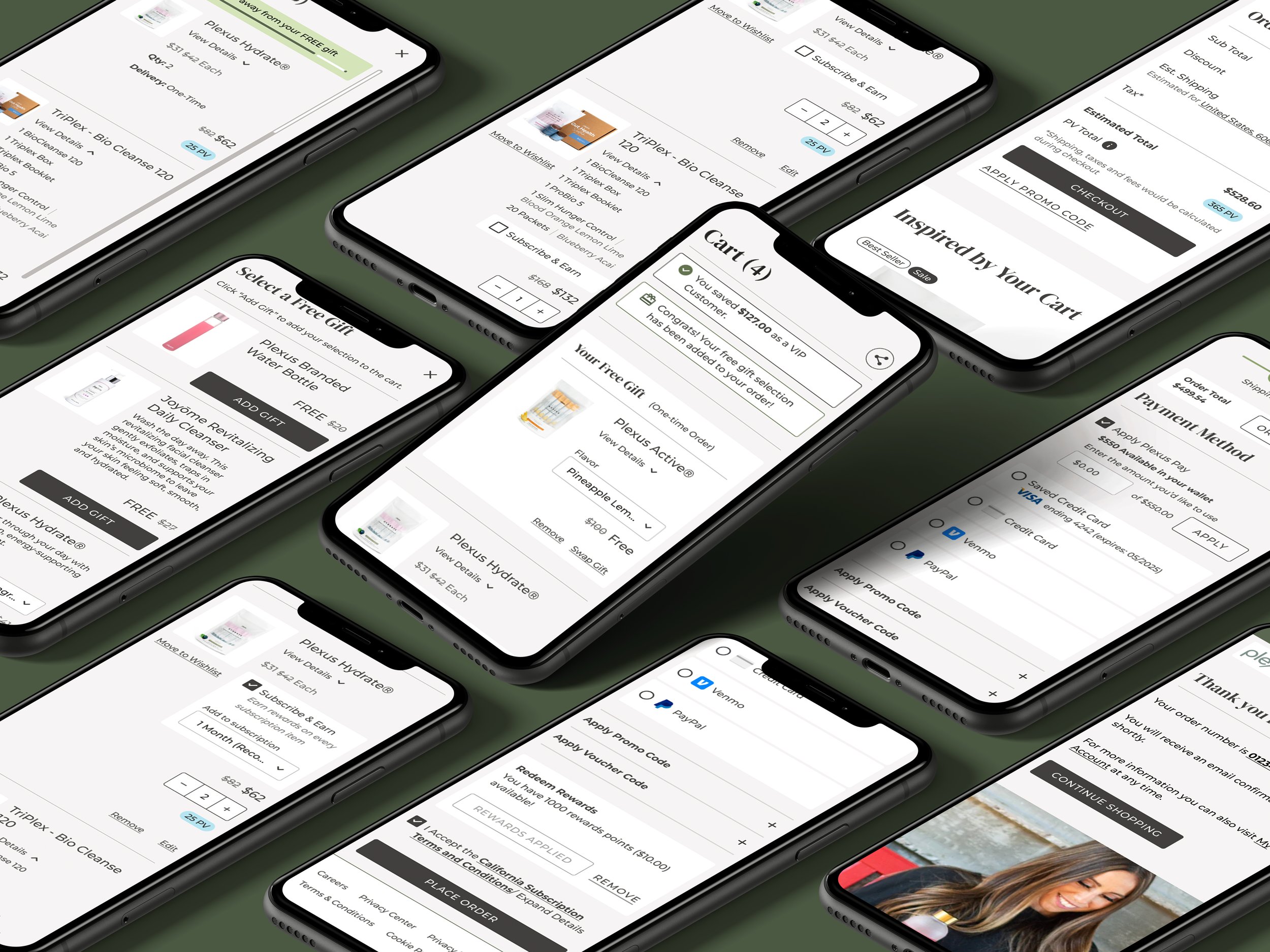
Custom Checkout
Personalized for each customer type
Plexus is a health and wellness company that sells products through a network of independent business owners called Brand Ambassadors.
Client
Plexus Worldwide
Year
2024
Role
Design Director
UX/UI Designer
Agency
Rightpoint
To improve conversion rates, we identified that creating a customized and optimized checkout experience, in line with eCommerce best practices, was crucial. Although Plexus serves three distinct customer types—unaware consumers, VIPs, and ambassadors—the current checkout process treats all customers the same, leading to missed opportunities for tailored engagement.
Key Issues Identified
-
There was a missed opportunity to engage and convert customers into higher-tier memberships, such as VIP or Ambassador statuses. Customers who were close to reaching the benefits of a VIP membership or who showed interest in the brand could have been encouraged to upgrade during their checkout process. By not highlighting membership perks or creating specific calls-to-action for upgrading, Plexus failed to capitalize on potential lifetime value from loyal customers.
-
Promotions were not clearly highlighted within the checkout process, causing them to be easily missed by customers. While promotions were embedded in product images or hidden in less prominent sections of the page, they lacked clear visibility or attention-grabbing design elements that could have encouraged customers to take advantage of discounts or special offers. This resulted in missed opportunities to drive sales and enhance the shopping experience.
-
The experience did not take into account the different needs of various customer types (unaware consumers, VIPs, and ambassadors) when recommending additional products. Cross-sell and up-sell opportunities were not personalized based on user preferences, past purchases, or browsing behavior. As a result, customers were not exposed to relevant products that could have increased their cart size and improved their overall shopping experience.
-
There was a lack of clarity around how discounts were applied. Users were not always able to distinguish between site-wide discounts, VIP-specific offers, or Ambassador deals. This ambiguity could have led to frustration or even a lack of confidence in the checkout process, potentially contributing to cart abandonment. Clear communication about the type and value of the discounts applied was essential for a smooth customer experience.
-
Terms like "estimated total" in the checkout were confusing for users, especially when shipping and tax calculations were not immediately clear. The language and structure of cost-related terms led to misunderstandings, with customers unsure about the final price they would pay. This lack of transparency created doubt or hesitation, contributing to cart abandonment or an incomplete checkout process. Clear, straightforward language needed to be used to define all costs, including shipping, taxes, and discounts, to provide users with a full understanding of their financial commitment.
-
Incomplete product details in the shopping cart made the checkout process feel disjointed. Information like flavors, quantities, sizes, and price breakdowns were not always displayed consistently. When customers could not easily review these details, it led to confusion or errors in the final order, causing them to hesitate or abandon the cart altogether.
-
Alternative payment methods were not given enough prominence during the checkout process, which deterred users from completing their purchases. Offering payment options such as Apple Pay, Google Pay, PayPal, and other express checkout methods was essential in catering to the diverse preferences of users. More payment choices would appeal to a broader customer base and reduce friction in the transaction process.
We recognized a key opportunity to streamline the user journey by reducing friction throughout the checkout process and tailoring the experience for each customer type. Our goal was to apply best practices in commerce design to make it easier for all users to complete transactions, whether they are purchasing a product, managing a subscription, or signing up as an ambassador.
By addressing these gaps, we aimed to create a seamless and personalized checkout experience that would drive conversion, loyalty, and growth.
Our Objectives
-
Streamline the checkout process to reduce friction and encourage users to complete their purchase from Cart > Checkout. This includes eliminating confusing steps, improving clarity, and enhancing the user experience.
-
Encourage customers to add more items to their cart by leveraging tailored recommendations, bundle offers, and cross-sell/upsell tactics that align with user preferences.
-
Enhance the value derived from subscription-based purchases by offering compelling incentives, personalized plans, and subscription bundles to encourage higher-value commitments.
-
Enhance the value derived from subscription-based purchases by showcasing cost savings.
-
Drive more customers to become VIP members or Ambassadors by highlighting the benefits and exclusive offers available to these membership types. This could increase customer loyalty and create more opportunities for repeat business and word-of-mouth marketing.
Custom Cart & Checkout
Retail Customer
Retail Cart
Membership promotion
Free gift earned
Product details
Custom product recommendations
Retail Cart
Membership added to cart as separate item
Features update to reflect VIP/Ambassador status
Retail Checkout Step 1
Membership reflected in Order Summary
Discounts and PV Points reflected
Retail Checkout Step 2
Add new payment method
New Subscription & Membership terms disclaimers
VIP/Ambassador Customer
VIP/Ambassador Cart
VIP Points saved
PV Points earned per item
Total PV Points earned
Amount saved per item
Total savings
VIP/Ambassador Cart
Subscription selection
Gift selection
VIP/Ambassador Checkout Step 1
Saved address
Discounts and PV Points reflected
VIP/Ambassador Checkout Step 2
Saved payment method
Ability to redeem points







